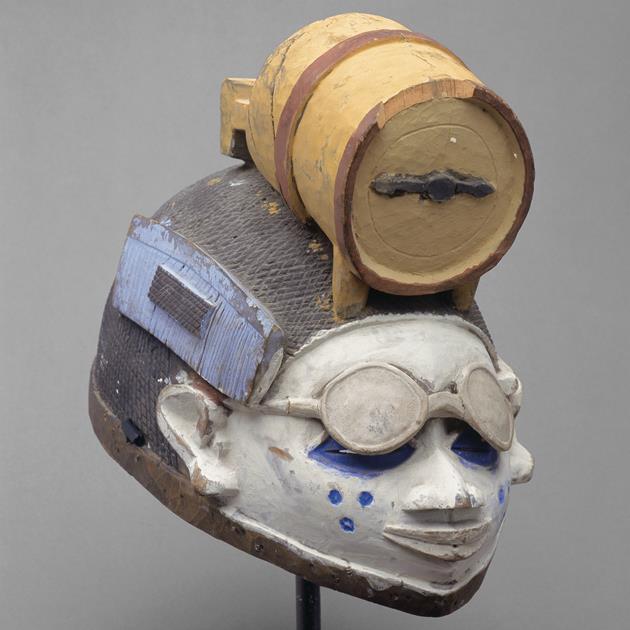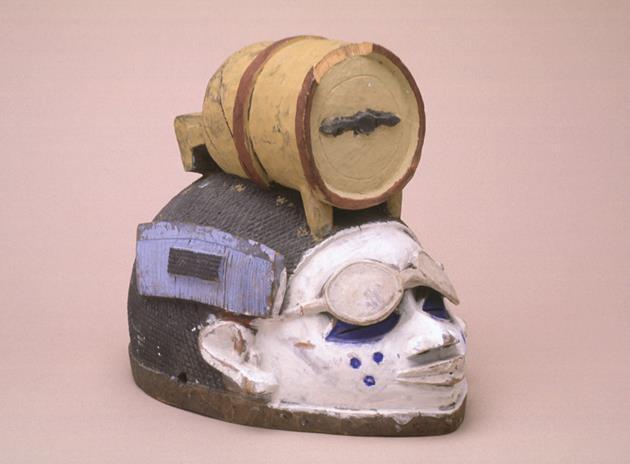Gelede Mask: Male Wearing Glasses
"A mockery of bad habits dominates this mask. A liquor barrel, dark glasses, fine-toothed comb, and cigarette over one ear are elements of a headdress that lampoons a certain elite. In the late nineteenth and early twentieth centuries, a group of Brazilian residents of African ancestry returned to Nigeria. They spoke Portuguese, were Catholic, and tended to segregate themselves. Following them were repatriates from Sierra Leone, more British oriented and Protestant. Both groups tended to part their hair as on this mask, drink Western liquor imported in barrels, and smoke. It is also possible that the mask simply refers to European colonialists who overindulged in drink, wore sunglasses, and smoked imported cigarettes. In assembling these clues, the mask jests as Gelede is best known to do: "In jesting, you approach someone in an intimate way-it is an aspect of friendship and it creates trust. It can promote well-being and purify a relationship." (Babatunde Lawal, 1999)
"The word Gelede describes a spectacle that relaxes and pacifies the beholder. Gelede is primarily dedicated to the maternal principal in nature personified as Iya Nla, the Great Mother; it is also aimed at promoting peace and social harmony within a particular community.
"The first part takes place at night, the Efe ceremony. During the ceremony, a mask called Efe-which means the humorist or joker-performs throughout the night, praying to the Great Mother to be very generous to the society. At the same time, the mask criticizes anti-social elements in the society. The emphasis of the Efe mask is on satire, on poetry.
At dawn, the Efe will withdraw, and then the crowd will gradually disperse. In the afternoon of the second day, small children come out to perform their own Gelede. By five o'clock, the marketplace is filled up once more, and then other Gelede masks arrive from different sections of town. Daylight masks do not sing-whatever they want to say is in the headdresses.
"Now the headdress with the keg of wine, plastic comb, cigarettes and sunshades is unique. Since we cannot reconstruct the original context of the headdress, it is difficult to be definite about the identity of the figure. Nonetheless, it may be a social commentary on the colonialists, who were known to be fond of drinking alcohol and may be an allusion to westernized Africans who have taken blindly to western ways. There is also a particular phrase, oyimbo, which refers to a particular type of illicit gene that makes an individual behave stupidly. It also refers to certain European attitudes or customs that the local people consider stupid-because even in the heat of the tropical weather, some Europeans put on ties and look like goats. In Africa, you use a rope to pull the goat.
As a result of the transatlantic slave trade between the sixteenth and late nineteenth centuries, hundreds of thousands of Yoruba were transplanted to the New World. Many of them took Gelede with them, and Gelede performance continued into the early twentieth century. Around 1988, a society known as the Society of Yemaya was formed in New York. In Gelede, nature becomes the nurturing element of culture with the Great Mother. Yemaya is personified as the Great Mother who could provide for people during slavery, and continued to do so in Cuba and Brazil. Gelede ceremony also influenced the carnivals of the Caribbean, and Mardi Gras in New Orleans. Yorubas were present in large numbers in New Orleans. There is a Yoruba village in Sheldon, South Carolina where there is a shrine dedicated to Yemaya, there are paintings and sculptures illustrating Gelede and Yemaya-so the Gelede tradition has been transformed in various ways in the Americas.
"Gelede headdresses were collected as far back as the 1880s, if not earlier. Some European missionaries asked their converts to surrender their masks. There are representations of Gelede masks in the works of European artists dating back to the nineteenth century. But most of the collectors did not bother about the names of the artists, they simply yanked off the headdress because that was regarded as most important. Retired headdresses were often given to children to practice with, but these days, they may be sold to dealers." (Babatunde Lawal, 2001)
Wood and pigment
9 1/2 x 7 13/16 x 11 9/16 in. (24.2 x 19.8 x 29.4 cm)
Gift of Katherine White and the Boeing Company
81.17.583
Provenance: [Emil Storrer, Zürich, Switzerland]; purchased from gallery by Katherine White (1929-1980), Seattle, Washington, 1972; bequeathed to Seattle Art Museum, Seattle, Washington, 1981
Photo: Paul Macapia



